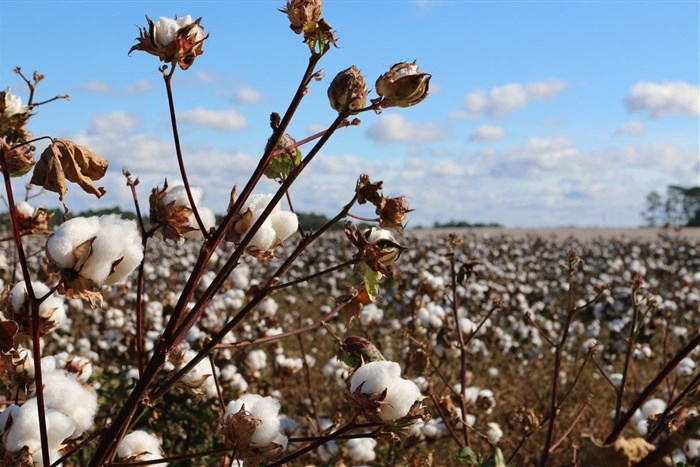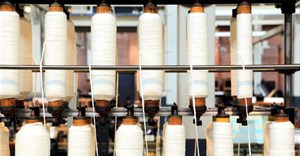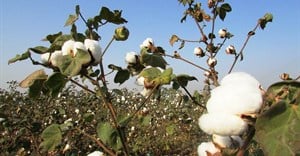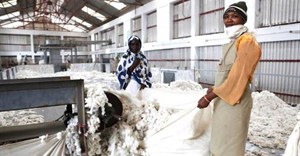
Subscribe & Follow
Cotton: A golden opportunity for South Africa?

A crop that thrives in conditions in which many others cannot, cotton can be stored for long periods without deteriorating and is hypoallergenic, biodegradable and carbon neutral.
Local is lekker
In the 2018/19 production year, South Africa produced 51,000 tonnes of lint cotton, representing an 800% increase in the five years since the South Africa Cotton Cluster (SACC) was established. Due to capability and capacity limitations of local cotton spinning, weaving and knitting, 80% of the cotton lint is being exported for processing. Products in various tiers of the manufacturing process are then imported again.
This situation seems counter-intuitive, especially when one considers that the possible opportunity cost to the economy of sacrificing local beneficiation amounts to around R20bn, according to agritech company, IQ Logistica. This figure does not even take into consideration the potential employment and skills development opportunities that have also been lost.
Currently, local clothing retailers are using between 25% and 30% of locally produced cotton products in their ranges but, at Cotton SA’s Global World Cotton Day seminar held in October 2020, and in a recent article published in Business Insider, many pledged to increase their commitment towards localisation substantially.
This begs the question, though, that if retailer demand increases, what are the implications for the value chain? Can we produce enough cotton for an increase in local demand and, if not, how many more hectares need to be planted and harvested to address this demand?
Based on research and historical crop statistics there is sufficient land suitable for cotton production available in South Africa to meet this demand. The cotton ginning capacity has also been upgraded over the past two years, with more than R300 million invested by the private sector. The bottlenecks to fulfil the full value chain within South Africa, however, lie with the spinners, knitters, weavers, dyeing, finishing, and to a lesser extent, garment manufacturing.
The shortage of specific spinning capacity means that most of the lint cotton is exported for processing and manufacture. Establishing a cotton spinning mill is very capital intensive, costing in the region of R600 million to set up, and further investment is needed to grow and sustain the local value chain.
The changes in the government structures over the past two years brought a new strategic approach to the manufacturing industry, which led to the development of the Retail, Leather and Footwear Masterplan. The funding guidelines were changed and a second funding application, which the Cluster submitted to the Industrial Development Corporation in December 2018, was not successful.
The economic impact of Covid-19 has reduced budgets and new applications will be considered again only after April 2021. With the decrease in the budget and the greater demand for increasing upstream competitiveness in the textile manufacturing industry, the possibility of government funding towards the local cotton programme is at risk. However, some private sector stakeholders, such as the MRP Group and Woolworths, are committed to localising the cotton industry.
While much emphasis is currently placed on increasing the commitment towards local manufacturing, it, unfortunately, does not always include the use of local raw products.
Cotton goes way beyond clothing
Cotton is unique in that it is the only crop that is both a food and a fibre crop. A total of 60% of all textile and apparel products contain a cotton element, but cotton is so much more than the fibre we are so familiar with in our clothes, towels, bedding and linen - 100% of the plant can be used.
Linters – the short fuzz on the seed – offer cellulose that is used in plastics, explosives, high-quality paper products such as banknotes, batting for mattresses and furniture, computer chipboards and flat-screen TVs. The cottonseed is crushed to separate it into three products. The oil is used in margarine, cooking oil, salad dressing, cosmetics, soap, candles, detergents and many other commodities. The meal is used in livestock, poultry and fish feed, as well as fertiliser, and the hulls are used in fertiliser, fuel and packaging. What is left of the plant – the stalks and leaves – is used for pressed paper and cardboard or ploughed back into the soil to enrich it.
Are these sectors as committed as the textile and apparel industries to supporting the South African cotton sector? For example, what percentage of margarine, cooking oil, salad dressing, cosmetics, soap, candles, detergents, livestock, poultry and fish feed, fertiliser and explosives is derived from South African cotton? Are South African banknotes made from South African cotton? Are there strategies in place to increase the use of locally produced cotton, as there are in the apparel and textile sector?
The good, the bad and the solution
According to Cotton SA, major advancements in agricultural innovation and technology combined with better crop management have contributed towards the increase in South African cotton production. The organisation is also driving an extensive consumer awareness campaign to encourage a greater appetite for locally produced cotton, with a South African Cotton Mark showing support for local cotton farmers.
This growth cycle in fibre production has, over the past year, unfortunately, been impacted by external factors, such as access to new seed technology (cultivars), weather conditions and some industry constraints at ginner level. These have resulted in a decrease in volumes over the past season as well as a forecasted decrease for the coming season and increasing the yield volumes remains critical.
In our view as a financier close to the cotton sector, a multipronged approach is what is needed to nurture this sector to reach its full potential:
• Foster financing and skills transfer partnerships. While the SACC is all about partnerships – with all stakeholders throughout the value chain committed to developing the sector – it is clear that the focus should be on building capacity throughout the value chain, with specific emphasis on the spinning process and beyond. This would include the financing of spinning and manufacturing plants and upskilling of labour to power these facilities.
It is thus gratifying to see that The Foschini Group’s factories in Maitland and Caledon in the Western Cape are currently running at 100% capacity and that the group is looking to expand these facilities over the next five years. Similarly, Pep Clothing has four local factory divisions manufacturing basic school clothing, knitted underwear and, more recently, personal protective equipment. It is also important not only to focus on the local manufacturing of the products but also to ensure the vertical integration of the local natural fibres.
• Develop the smallholder farming sector to further increase production capability while creating job opportunities. This is an area close to our heart, and the wheels are in motion to explore a blended finance solution specifically for smallholder farmers, in partnership with Cotton SA and other stakeholders. The MRP Group has also focused much of its energy on assisting with financing in this area and is heartened to see a strong increase in women under the age of 35 becoming involved, thus contributing to gender and youth development.
Nedbank, for example, recently supported and sponsored the Agri Seta certificate award ceremony hosted by Cotton SA in Mpumalanga. Twenty-nine farmers from the Lebombo Agricultural Secondary Cooperative received their awards for completing the Agri Seta cotton training.
• Diversify the market for South African cotton. With the Green Deal that is driving economic recovery in Europe, Better Cotton Initiative (BCI)-compliant cotton will become more and more important in that market, and South African cotton is well placed to cash in on this demand.
While 44% of the past season of South Africa’s cotton crop is currently BCI-compliant, the global average of BCI-compliant cotton is just 22%. Cotton SA is the BCI implementing partner in South Africa, driving the process of making 100% of South African cotton BCI-compliant within the next three to five years, which we are also supporting in collaboration with ISEAL and Cotton SA.













